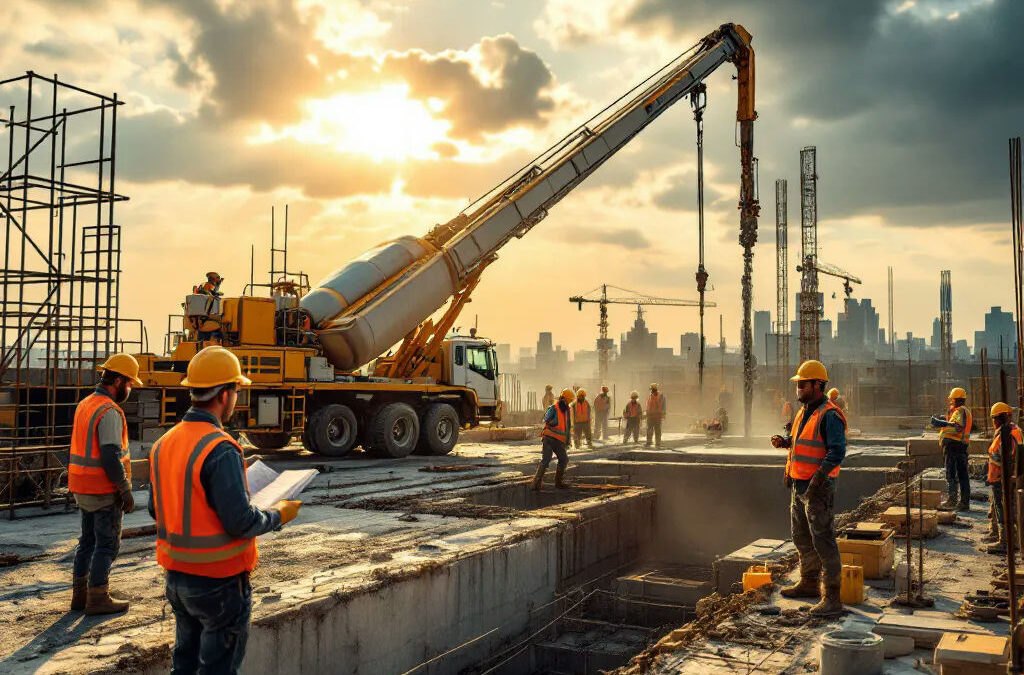Introduction
In the construction industry, safety is paramount, especially during commercial concrete pours. The risks associated with concrete pouring can lead to severe injuries and costly setbacks if not managed properly. This article outlines essential safety measures to ensure a safe and efficient concrete pouring process.
Pre-Pour Safety Measures
Site Assessment
Conducting a thorough site assessment is the first step in ensuring safety during a concrete pour. Identify potential hazards such as unstable ground, overhead power lines, and nearby traffic. Additionally, consider environmental factors like weather conditions that may affect the stability of the pour and the safety of workers.
Equipment Inspection
Before beginning any pour, it is crucial to inspect all equipment thoroughly. Ensure that concrete mixers, pumps, and other machinery are functioning correctly to prevent malfunctions that could lead to accidents. Don’t forget to check personal protective equipment (PPE) to confirm it is in good condition and suitable for the tasks ahead.
Team Training
Effective safety measures hinge on well-trained staff. Implement comprehensive safety training programs tailored to the concrete pouring process, including hazard recognition and proper equipment use. Regular emergency response drills should also be conducted to prepare the team for unexpected incidents.
Personal Protective Equipment (PPE)
Essential PPE for Concrete Pouring
Using the right personal protective equipment is vital during commercial concrete pours. Essential items include hard hats to protect against falling objects, safety goggles to shield eyes from flying debris, gloves for hand protection against rough materials, and steel-toed boots to safeguard feet from heavy loads. Each piece of PPE serves a critical function in minimizing injury risk.
Importance of Proper PPE Usage
The effectiveness of PPE depends on proper usage. Workers should be trained not only on what gear to wear but also on how to use it correctly. Regular inspections of all PPE should be conducted to ensure they remain effective, as wear and tear can compromise their protective capabilities.
Communication Protocols
Establishing Clear Roles and Responsibilities
Effective communication is essential in minimizing risks on the job site. Establish clear roles and responsibilities for all team members involved in the concrete pour. This ensures that everyone knows who to consult in case of an issue and helps to streamline operations.
Using Hand Signals and Other Communication Methods
Given the noisy environment during concrete pours, using hand signals and other non-verbal communication methods is beneficial. Standardized signals help maintain clarity and prevent misunderstandings. Additionally, ensure regular safety briefings are held to discuss any updates or concerns.
Concrete Pouring Process
Planning the Pour
Thorough planning is critical to a successful concrete pour. Understand the pour timeline and identify the best times to pour based on weather forecasts. If inclement weather is expected, adjust your plans accordingly to safeguard both the concrete and the workers involved.
Handling Materials
Safe practices for handling materials during the pour significantly reduce the risk of accidents. Workers should be trained to move and mix concrete appropriately to prevent slips and falls. Always implement safety barriers and signage around the work area to keep non-essential personnel away from potential hazards.
Curious about the right materials to use for your commercial pour? Learn more in our article on how to choose the right concrete mix for your commercial project.
Post-Pour Safety Measures
Clean-Up Procedures
Post-pour procedures are just as vital as pre-pour measures. Ensure proper disposal of leftover materials and clean equipment to prevent hazards from leftover debris. A thorough clean-up also helps ensure the site is safe for workers returning to the area after the pour.
Evaluating the Pour
After the completion of the pour, evaluate the entire process to identify any safety incidents that may have occurred. Reviewing feedback from team members can provide valuable insights into improving future practices and reinforcing a culture of safety on job sites.
Conclusion
Prioritizing safety in commercial concrete pours is crucial for protecting workers and ensuring successful project completion. By implementing the key safety measures discussed, teams can significantly reduce risks and enhance project efficiency. Whether through pre-pour inspections or post-pour evaluations, a commitment to safety must be woven into every phase of the project.
For a safe and professional concrete pour, call us now at 916-562-2345 to get a quote and speak with our team today.


